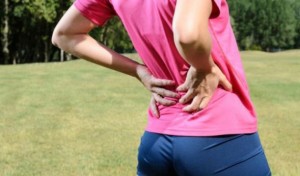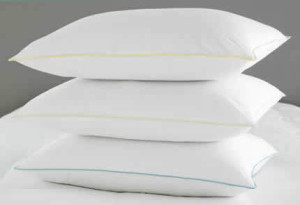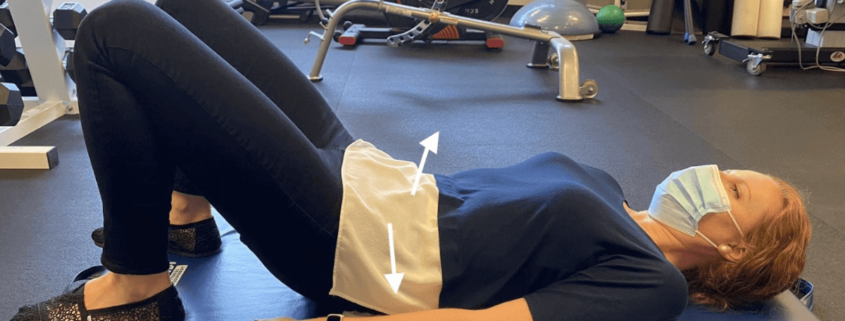Tag Archive for: Low Back Pain
 Most cases of low back pain can be caused by a variety of problems, including muscle strain or sprain, herniated disc or degenerative disc disease. Typical sources of low back pain include:
Most cases of low back pain can be caused by a variety of problems, including muscle strain or sprain, herniated disc or degenerative disc disease. Typical sources of low back pain include:
- Osteoarthritis
- Muscle spasm
- Ruptured or herniated disk
- Sciatica
- Strain or tears to the muscles or ligaments supporting the back
- The nerve roots in the low back, may be irritated
- The bones, ligaments or joints may be damaged
Low back pain from a muscle strain is the most common and can be caused by lifting a heavy object, lifting while twisting, or a sudden movement or fall. While pain or discomfort can happen anywhere in your back, the most common area affected is your low back.
When the muscles in the low back are strained or torn, the area around the muscles becomes inflamed. This inflammation causes the muscles in the back to spasm and cause low back pain.
Treatment for low back pain depends upon the patient’s history and the type and severity of pain. The vast majority of lower back pain cases get better within six to eight weeks.
Treating low back pain consists of a combination of treatments, such as Chiropractic, Massage, Physiotherapy, Acupuncture, Cryo/Hydro Therapy, Laser Therapy, TENS therapy, Ultrasound, eToims, Decompression Table, Graston Technique, Shockwave Therapy, Neuro-mechanical Adjusting Tool as well as topical ointments such as Traumeel and nutritional supplements that help with inflammation.
An exercise program is necessary and essential to rehabilitate the spine, increase your range of motion and help alleviate back pain.
With the first symptoms of low back pain, stop the activity for the first few days; this allows injured tissue to begin to heal, and reduce any swelling or inflammation. You can also apply heat/ice to the painful area. Always use ice for the first 48-72 hours, then use heat. You can also take something to help with the inflammation such as ibuprofen or nutritional supplements.
 Pillows impact the quality of our sleep – and sleeping on the wrong pillow can contribute to headaches, neck, should and lower back pain. Pillows are designed to keep the spine in a natural alignment. The human neck curves slightly forward and it’s important to maintain this curve when in a resting position.
Pillows impact the quality of our sleep – and sleeping on the wrong pillow can contribute to headaches, neck, should and lower back pain. Pillows are designed to keep the spine in a natural alignment. The human neck curves slightly forward and it’s important to maintain this curve when in a resting position.
According to the Canadian Chiropractic Association, 80 per cent of Canadians will suffer from back pain at some point in their lives, and sleeping with the proper pillow is a simple way to prevent problems.
A pillow should mold to one’s individual shape and alleviate any pressure points. If the height of the pillow is too high when sleeping the neck is bent forward or to the side, causing muscle strain on the back of the neck and shoulders.
Based on the body’s measurements, a pillow should maintain a height of 10 to 15 centimeters to properly supporting the head, neck and shoulders.
How do you know if you need a new pillow…the general rule is you need to replace your pillows every 12 to 18 months. Old pillows can contain skin cells, mold, fungus, and dust mites, which make up more than half of the pillow’s weight. Still not sure if you should be purchasing a new pillow? Fold your pillow in half and see if it unfolds, or pick up your pillow and place it on your hand, if it stays flat that’s good, however if the sides flop down, it’s time to purchase a new pillow.
Buying a new pillow: The goal of using a pillow is to keep your head in a ‘neutral alignment, so…
- If you sleep on your back, use a thinner pillow that’s not too firm or too high so that your head is not thrown too far forward. Back sleepers should use memory foam, because it molds to the head and neck’s curve.
- If you sleep on your side, use a firmer pillow, which will fill in the distance between the ear and the shoulder. Look for a firm or extra firm pillow that supports the space under your neck when lying down.
- If you’re a stomach sleeper, use a very thin, flat pillow. This sleep style isn’t recommended, because of the stress it places on the lower back.
Pillow options: The most common materials used in pillows are: down, feather, foam, polyester fiberfill, memory foam, latex and organic products such as buckwheat hulls.
- Goose down or feather pillows are long-lasting and excellent in terms of comfort
- Memory foam pillows conforms to your movements and distributes weight evenly
- Buckwheat hull and other organic pillows will remain cool throughout the night
Can’t find exactly what you need, try a pillow with a combination of material. Some memory-foam pillows are constructed with polyester microfibre to give the “feel” of a down pillow, but with extra shape to provide more support.
There is no perfect pillow for everyone; if the pillow feels comfortable, you’ll get a good night’s sleep, and sleep is the body’s chance to repair itself from the postural and physical demands of everyday.
 Whether you are interested in road cycling, mountain biking, or just commuting to work, cycling injuries can happen to anyone. In this article we will discuss three common bike injuries.
Whether you are interested in road cycling, mountain biking, or just commuting to work, cycling injuries can happen to anyone. In this article we will discuss three common bike injuries.
Achilles Tendonopathy: Achilles tendonopathy is an overuse injury caused by a breakdown of the tendon. If you have tight calf muscles, spending several minutes performing heel raises before beginning your ride will reduces the risk of injury.
Achilles tendonopathy can also be caused by poor bike fit. Having the bike seat too high keeps the positions of your foot and toes pointed down, causing constant contraction of the calf muscles. When the foot and toes point up during the bottom portion of the pedal stroke, the tension on the Achilles is released and this allows the tendon to have needed periods of rest.
Saddle Sores: A saddle sore is a skin disorder caused by long hours on a bike seat; which is caused by the friction of your sit bones against the seat. Having your bike seat too high can also causes this condition. Lowering your bike seat can lessen the side-to-side motion of the pelvis, which can cause excessive friction against the seat. If you are still having problems, perhaps a different style of bike seat might provide relief. Also, make sure your bike shorts are providing enough cushion/protection between you and the seat.
Lower Back Pain: Biking for long periods of time in a “riding” position is a major cause of lower back pain. Excessive flexion in the lumbar region of the spine can lead to nerve entrapment and sciatica.
Biking often overlooks core muscles, and having weak muscles can lead to low back pain by forcing supporting muscles to compensate for weaker muscles. Back pain can also be caused by a leg length discrepancy or misalignment of the spine. For more information on how to strengthen your core, please contact our physiotherapists.
Riding a bike that is too big for your frame, can also cause lower back pain; so take the time to have your bike fitted to your body: finding the correct body position on a bike will help avoid future biking injuries.
Hamstring Stretches Help with Low Back Pain | physiotherapy victoria bc:
One of the most important stretches someone with low back pain should be performing is a hamstring stretch. When your hamstrings are tight, it places a lot of stress on your low back, leading to more pain and can actually cause more difficulty for you.
One of the easiest ways to stretch your hamstrings is lying on your back. Bring your knee toward your chest and straighten out your knee and try to push the bottom of your foot up towards the ceiling. The opposite leg should be flat. Then rest and repeat. This should be performed on each side.

Hamstring Stretches
An important aspect to stretching is being able to relax while you are doing the stretch. If you find yourself not relaxing with the first stretch, try lying near a door jam or a corner of a wall and place one leg up on the wall. Now drop the opposite leg and you’ll begin feeling the stretch in the back of the hamstring. This is a nice stretch because you can just relax and it doesn’t place as much stress on your low back. The object here is to work your leg up the wall to try to get a ninety degree angle. Now once your leg is straight, simply return to the starting position, slide your hips closer to the wall, and repeat.
Since hamstring stretching should be done at least twice a day, finding other positions which you can incorporate into your daily routine is crucial. Another way to stretch your hamstring is sitting on the edge of a chair, so it can be done almost anywhere. Sitting in the chair, scoot to the edge of the chair, straighten out one leg, and point your toes toward the ceiling. Simply sit up straight and roll your pelvis forward and you should feel a light stretch up the back of your leg. This can be held for approximately thirty seconds, and repeated on each side.
For more information on stretches that you can do at home or at the office please contact our physiotherapists.
News & Events
- About Matthew Bryan, DC November 7, 2025
- The Benefits of Shockwave Therapy Treatments February 28, 2023
- Piriformis Syndrome: A Real Pain in the Butt January 31, 2023
- Searching for a Personal Trainer in Victoria to Help You Achieve Your Goals? December 31, 2022
- Are Winter Blues + Holiday Stress Making You Feel Grinchy? November 28, 2022
- Fact or Fiction? Is Joint Pain Worse in Cold Weather? October 28, 2022
- Pelvic Health During Pregnancy and Postpartum Workshop September 26, 2022

Diversified Health Clinic
| Monday | 7 a.m. – 6 p.m. |
| Tuesday | 7 a.m. – 6 p.m. |
| Wednesday | 7 a.m. – 6 p.m. |
| Thursday | 7 a.m. – 6 p.m. |
| Friday | 7 a.m. – 6 p.m. |
| Saturday | 8 a.m. – 5 p.m. |
| Sunday | Closed |

